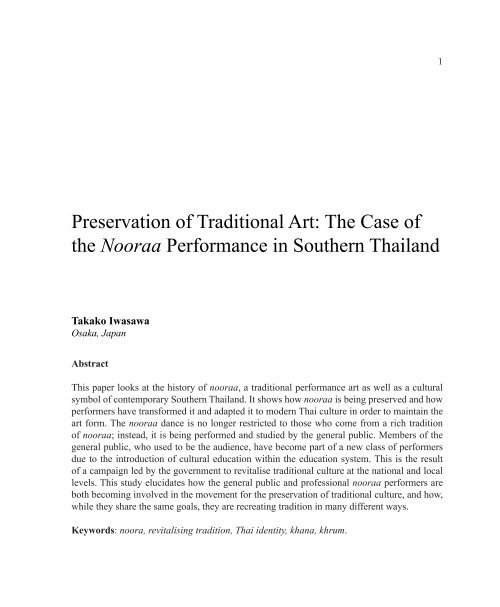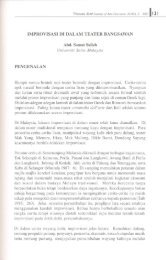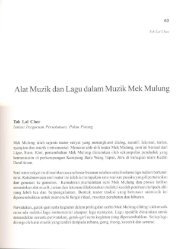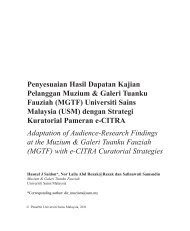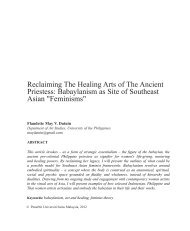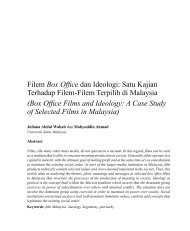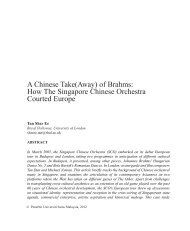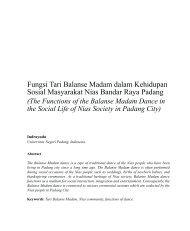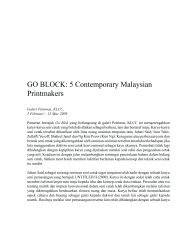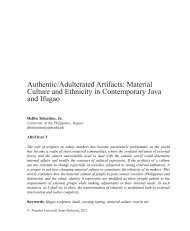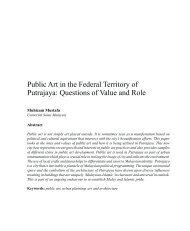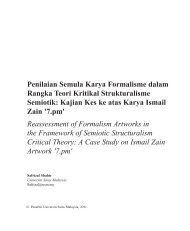Preservation of Traditional Art: The Case of the ... - Wacana Seni
Preservation of Traditional Art: The Case of the ... - Wacana Seni
Preservation of Traditional Art: The Case of the ... - Wacana Seni
You also want an ePaper? Increase the reach of your titles
YUMPU automatically turns print PDFs into web optimized ePapers that Google loves.
1<strong>Preservation</strong> <strong>of</strong> <strong>Traditional</strong> <strong>Art</strong>: <strong>The</strong> <strong>Case</strong> <strong>of</strong><strong>the</strong> Nooraa Performance in Sou<strong>the</strong>rn ThailandTakako IwasawaOsaka, JapanAbstractThis paper looks at <strong>the</strong> history <strong>of</strong> nooraa, a traditional performance art as well as a culturalsymbol <strong>of</strong> contemporary Sou<strong>the</strong>rn Thailand. It shows how nooraa is being preserved and howperformers have transformed it and adapted it to modern Thai culture in order to maintain <strong>the</strong>art form. <strong>The</strong> nooraa dance is no longer restricted to those who come from a rich tradition<strong>of</strong> nooraa; instead, it is being performed and studied by <strong>the</strong> general public. Members <strong>of</strong> <strong>the</strong>general public, who used to be <strong>the</strong> audience, have become part <strong>of</strong> a new class <strong>of</strong> performersdue to <strong>the</strong> introduction <strong>of</strong> cultural education within <strong>the</strong> education system. This is <strong>the</strong> result<strong>of</strong> a campaign led by <strong>the</strong> government to revitalise traditional culture at <strong>the</strong> national and locallevels. This study elucidates how <strong>the</strong> general public and pr<strong>of</strong>essional nooraa performers areboth becoming involved in <strong>the</strong> movement for <strong>the</strong> preservation <strong>of</strong> traditional culture, and how,while <strong>the</strong>y share <strong>the</strong> same goals, <strong>the</strong>y are recreating tradition in many different ways.Keywords: noora, revitalising tradition, Thai identity, khana, khrum.
2<strong>Wacana</strong> <strong>Seni</strong> Journal <strong>of</strong> <strong>Art</strong>s Discourse. Jil./Vol.7.2008IntroductionNooraa is a genre <strong>of</strong> traditional performance art that is found in Sou<strong>the</strong>rn Thailand andNor<strong>the</strong>rn Malaysia 1 . It combines dance, music, singing, narrative verse, <strong>the</strong>atrical play, sorceryand ritual. It is believed to be among <strong>the</strong> oldest <strong>the</strong>atrical traditions in Thailand, and it isalso considered to be <strong>the</strong> ancestor <strong>of</strong> <strong>the</strong> Thai dance drama lakhon, which is a genre that wasdeveloped and perfected under <strong>the</strong> patronage <strong>of</strong> royalty and <strong>the</strong> aristocracy in central Thailand.Although <strong>the</strong> exact date and place <strong>of</strong> origin are not known, it is believed that nooraa dates backfive to seven hundred years (Guelden 2005: 181). According to sou<strong>the</strong>rn Thai mythology, <strong>the</strong>performance most likely evolved in <strong>the</strong> region around Songkhla Lake, <strong>the</strong> largest inland body<strong>of</strong> water in <strong>the</strong> country.Since ancient times, nooraa performers have not resided in a fixed place, as <strong>the</strong>ir performancesrequire <strong>the</strong>m to travel around <strong>the</strong> countryside. When troupes received an <strong>of</strong>fer from clients, <strong>the</strong>ywould set out on a journey, but <strong>the</strong>y would return home after <strong>the</strong> show to engage in farming,fishing and o<strong>the</strong>r work to supplement <strong>the</strong>ir income. <strong>The</strong> lifestyle <strong>of</strong> <strong>the</strong> nooraa performers canthus be categorised as a semi-nomadic 2 one. <strong>The</strong>ir lives are divided between seasons on <strong>the</strong>road and seasons spent working in <strong>the</strong> fields.Nooraa performers are constantly adapting to <strong>the</strong> changes in Thai society so as to keepaudiences satisfied and entertained. <strong>The</strong>y are also troubled by <strong>the</strong> difficulty <strong>of</strong> finding newperformers, as <strong>the</strong> younger generation today prefers to work in modernised companies locatedin urban areas where income is more stable.In this paper, I explore <strong>the</strong> question <strong>of</strong> how nooraa performance art has changed and how it isbeing revived and revitalised. I focus on two groups <strong>of</strong> people engaged in <strong>the</strong> revitalisation <strong>of</strong>nooraa: nooraa pr<strong>of</strong>essional performers and amateur nooraa activists who are concerned withreviving <strong>the</strong> arts using various methods, including efforts in schools and universities. 3
3Takako IwasawaNooraa in <strong>the</strong> <strong>Traditional</strong> ContextBefore examining <strong>the</strong> current status <strong>of</strong> nooraa, we need to describe what <strong>the</strong> originalpractitioners <strong>of</strong> nooraa were like. After we gain a deeper appreciation <strong>of</strong> <strong>the</strong> history behindnooraa, it will <strong>the</strong>n be appropriate to discuss <strong>the</strong> new challenges faced by nooraa performersand <strong>the</strong> transformation that is occurring in nooraa performances and among <strong>the</strong> performers<strong>the</strong>mselves.In <strong>the</strong> traditional context, we can categorise those who are involved in nooraa performanceinto two groups: members <strong>of</strong> nooraa troupes and main audiences. I will attempt to look at <strong>the</strong>roles that both troupes and audiences play.<strong>The</strong> Nooraa troupeA nooraa troupe is made up <strong>of</strong> several components. A troupe generally consists <strong>of</strong> dancers,musicians, sorcerers, and attendants. <strong>The</strong> number <strong>of</strong> individuals in a troupe can range fromfourteen to twenty people (Udom Nuuthaung 2536/1993: 31–32). <strong>The</strong> group <strong>of</strong> dancers ismade up <strong>of</strong> seven to ten people. This includes a nooraa master, known as <strong>the</strong> nooraa yai, whoplays <strong>the</strong> role <strong>of</strong> <strong>the</strong> troupe leader. <strong>The</strong> o<strong>the</strong>r dancers are called naang ram. <strong>The</strong> dancers have awide range <strong>of</strong> performing abilities: <strong>the</strong>y not only dance but also sing songs, perform narratives,and act. However, <strong>the</strong>ir main role in <strong>the</strong> performance is to dance, a fact made evident by <strong>the</strong>name given to <strong>the</strong>m, naang ram, which means dancer.A nooraa troupe requires five to seven musicians, called luuk khuu. <strong>The</strong> traditional musicalensemble includes <strong>the</strong> pi, a double-reed, oboe-like shawm; <strong>the</strong> thap, a pair <strong>of</strong> goblet-shapeddrums; <strong>the</strong> ching, a pair <strong>of</strong> small hand cymbals; <strong>the</strong> mong, a pair <strong>of</strong> small brass gongs in awooden box; <strong>the</strong> krap, a wooden clapper; and <strong>the</strong> klong, a two-faced drum. <strong>The</strong> musicians
4<strong>Wacana</strong> <strong>Seni</strong> Journal <strong>of</strong> <strong>Art</strong>s Discourse. Jil./Vol.7.2008who play <strong>the</strong>se musical instruments also form <strong>the</strong> chorus. When <strong>the</strong> master sings an invocationverse, <strong>the</strong> musicians follow <strong>the</strong> master and sing while playing <strong>the</strong>ir own instruments inantiphonal (call and response) style. <strong>The</strong> dancers are <strong>of</strong>ten called upon to help <strong>the</strong> musiciansplay <strong>the</strong> instruments.Every troupe has one dance master who leads <strong>the</strong> troupe. <strong>The</strong> dance master, nooraa yai, has<strong>the</strong> ability to perform special magic and also <strong>of</strong>fers highly-developed knowledge and skill. Heacts as a sorcerer and is referred to as <strong>the</strong> mau kop roong 4 . Dance masters use <strong>the</strong>ir magicalknowledge to guarantee healing and a successful performance as <strong>the</strong>y manipulate <strong>the</strong> spiritualpowers <strong>of</strong> <strong>the</strong> nooraa teachers through possession and incantation. <strong>The</strong> last position in anooraa troupe is <strong>the</strong> attendant, known as taa sua. <strong>The</strong> attendant is not a performer but insteadis responsible for making arrangements for <strong>the</strong> travelling show and assisting <strong>the</strong> performers.From ancient times up until <strong>the</strong> early twentieth century, <strong>the</strong> passing down <strong>of</strong> traditional nooraahas been undertaken solely by male performers. In <strong>the</strong> twentieth century, female nooraaperformers started to enter this highly exclusive performing world, and today <strong>the</strong>y have becomevery active, surpassing male performers in number. In general, male nooraa performers stillsecure <strong>the</strong> most important roles in this tradition, especially <strong>the</strong> role <strong>of</strong> <strong>the</strong> ritual master. <strong>The</strong>ritual masters have not given up <strong>the</strong>ir position to make way for female nooraa masters. Guelden(2005) sees this as one <strong>of</strong> <strong>the</strong> challenges women face in this exclusive performing society.
5Takako IwasawaAudiences<strong>Traditional</strong>ly, both <strong>the</strong> performers and <strong>the</strong> audience have played important roles in nooraa.Nooraa performers generally have two different types <strong>of</strong> audiences. <strong>The</strong> first type <strong>of</strong> audienceconsists <strong>of</strong> <strong>the</strong> kin <strong>of</strong> nooraa performers, including <strong>the</strong> family members <strong>of</strong> <strong>the</strong> living nooraaperformers and <strong>the</strong> descendants <strong>of</strong> <strong>the</strong> dead nooraa performers. <strong>The</strong> second group <strong>of</strong> audiencemembersconsists <strong>of</strong> <strong>the</strong> general public, those not related to nooraa performers. <strong>The</strong> familymembers <strong>of</strong> <strong>the</strong> nooraa performers are <strong>of</strong> great importance, as <strong>the</strong>y are seen as <strong>the</strong> ones whoimpart knowledge and wisdom to <strong>the</strong> nooraa performers. <strong>The</strong>y are <strong>the</strong> main participants <strong>of</strong><strong>the</strong> ritual called nooraa roong khruu (roong: building; khruu: spirit-teacher). This ritual isrecognised as <strong>the</strong> most valued activity <strong>of</strong> nooraa performers and o<strong>the</strong>r ritual participants. <strong>The</strong>descendants <strong>of</strong> nooraa performers are expected to perform <strong>the</strong> ritual regularly in order topay homage to <strong>the</strong> spirit-teacher <strong>of</strong> nooraa. To conduct <strong>the</strong> ritual, an <strong>of</strong>fering <strong>of</strong> food and aperformance are required to be presented to <strong>the</strong> spirit-teacher. <strong>The</strong>refore, <strong>the</strong> person hosting<strong>the</strong> ritual will invite <strong>the</strong> pr<strong>of</strong>essional nooraa troupe to practice <strong>the</strong> ritual. <strong>The</strong> leader <strong>of</strong> <strong>the</strong>troupe takes charge as <strong>the</strong> ritual master and leads all <strong>of</strong> <strong>the</strong> participants. Nooraa roong khruuis also acknowledged as <strong>the</strong> symbolic space to which spirit-teachers descend. Through <strong>the</strong>practice <strong>of</strong> <strong>the</strong> ritual, both nooraa performers and audiences can have strong connections wi<strong>the</strong>ach o<strong>the</strong>r because <strong>the</strong>y belong to <strong>the</strong> same group, named chua saai nooraa, which is headedby <strong>the</strong> spirit-teacher.In <strong>the</strong> sou<strong>the</strong>rn part <strong>of</strong> Thailand, a unique communal group known as chua saai nooraa hasbeen organised by <strong>the</strong> people who live <strong>the</strong>re. Chua means source and saai means line. Chuasaai nooraa is characterised by <strong>the</strong> two lines <strong>of</strong> human relationships: that <strong>of</strong> <strong>the</strong> teacherdiscipleand that <strong>of</strong> <strong>the</strong> ancestor-descendant. <strong>Traditional</strong>ly, nooraa performances have beenpassed down from grandfa<strong>the</strong>r, fa<strong>the</strong>r or uncle to grandson, son, or nephew through a system <strong>of</strong>patrilineal inheritance. Men born in nooraa families have been expected to become performers
6<strong>Wacana</strong> <strong>Seni</strong> Journal <strong>of</strong> <strong>Art</strong>s Discourse. Jil./Vol.7.2008in order to maintain and continue <strong>the</strong> family tradition. If <strong>the</strong>y did not become performers, <strong>the</strong>descendants <strong>of</strong> nooraa were required to be good audiences or patrons.<strong>The</strong> members <strong>of</strong> chua saai nooraa have strong beliefs in <strong>the</strong> occult power <strong>of</strong> nooraa. Tobenefit from <strong>the</strong> power <strong>of</strong> <strong>the</strong> spirit-teacher, <strong>the</strong>y practice <strong>the</strong> ritual <strong>of</strong> paying homage to <strong>the</strong>spirit-teacher. By carrying out this ritual regularly, <strong>the</strong> descendants come to understand hownooraa performances work. <strong>The</strong>y understand how to communicate with <strong>the</strong> spirit-teacher and<strong>the</strong> original myth <strong>of</strong> nooraa through <strong>the</strong> intermediary <strong>of</strong> <strong>the</strong> pr<strong>of</strong>essional nooraa performers.In accordance with tradition, most performers come from a nooraa lineage, but it is possiblefor o<strong>the</strong>rs to enter into <strong>the</strong> nooraa world. Once someone who does not belong to <strong>the</strong> nooraalineage becomes a nooraa performer, his or her family members automatically become part <strong>of</strong><strong>the</strong> nooraa community, chua saai nooraa.Throughout time, members <strong>of</strong> chua saai nooraa have supported this genre <strong>of</strong> performanceas performers, audience-members and patrons. In <strong>the</strong> traditional context, nooraa is knownas a ritual performance meant to foster communication with <strong>the</strong> spirit-teacher ra<strong>the</strong>r than asa form <strong>of</strong> entertainment. However, in contemporary Thailand, as a result <strong>of</strong> <strong>the</strong> influence <strong>of</strong>modernisation and development <strong>of</strong> mass media, <strong>the</strong> traditional practitioners who can manipulatethis occult power are gradually decreasing. In order to survive, <strong>the</strong> traditional performers havebeen forced to change <strong>the</strong>ir performances, which were formerly based on communication with<strong>the</strong> spirit-teacher, into performances that focus more on entertainment. Due to this change,noorra has come to accept a new type <strong>of</strong> practitioner: <strong>the</strong> amateur performer who does notnecessarily have any background in this spiritual power.<strong>The</strong> next section describes two current trends among <strong>the</strong> pr<strong>of</strong>essionals and amateurs who aretrying to revitalise this art tradition. How has <strong>the</strong> nooraa performance evolved in contemporarysociety? Can <strong>the</strong> form be sustained through change?
7Takako IwasawaRevitalisation <strong>of</strong> Tradition among <strong>the</strong> Pr<strong>of</strong>essionalsIn contemporary Thailand, pr<strong>of</strong>essional performers <strong>of</strong> nooraa have had to contend with twoambiguous tendencies: commercial entertainment and au<strong>the</strong>ntic art traditions. <strong>The</strong>y can bedivided into beap saakhon (beap: style, saakhon: western, universal) and beap booraan(booraan: traditional). <strong>The</strong> former is westernised performance that eliminates some traditionalparts such as <strong>the</strong> ritual performance and employs modern instruments and styles in order totarget younger audiences. <strong>The</strong> latter follows a more traditional performance style, though it isnot necessarily <strong>the</strong> same style as that <strong>of</strong> traditional performances where particular attention isgiven to ritual.Modernisation <strong>of</strong> performance: <strong>The</strong> emergence <strong>of</strong> beap saakhonDuring <strong>the</strong> late 1960s, nooraa was divided into two overlapping categories—performance forcommercial entertainment and performance for ritual purposes. By combining western musicaltechnology with Thai songs, nooraa was repackaged to appeal to modern sou<strong>the</strong>rn Thai tastesat large outdoor country fairs where ancestral rites were increasingly being excluded (Guelden2005: 185).According to Ginsburg (1972), many <strong>of</strong> <strong>the</strong> old nooraa troupes have survived. In order tocompete with new forms <strong>of</strong> entertainment that are vastly appealing to <strong>the</strong> modern rural audience,<strong>the</strong>y have resorted to emulating modernised entertainment styles. Ginsburg (1972: 172) arguesthat <strong>the</strong> most successful troupes today 5 copy <strong>the</strong> luk thung formula ‘where performers inwestern dresses sing long narrative ballads with romantic <strong>the</strong>mes, accompanied by a westernstyle band, with interspersed comic skits and jokes while retaining perhaps a smattering <strong>of</strong> <strong>the</strong>traditional dance and comic verse’.
8<strong>Wacana</strong> <strong>Seni</strong> Journal <strong>of</strong> <strong>Art</strong>s Discourse. Jil./Vol.7.2008<strong>The</strong> new style <strong>of</strong> nooraa that has emerged more recently is called nooraa beap saakhon. It isdifferentiated from <strong>the</strong> traditional style, nooraa beap booraan (Suphat Naakseen 2539/1996:30). This new style, however, is not completely westernised or modernised. Beap saakhon is amix <strong>of</strong> traditional and modern /western styles. In 1999, I observed a modern nooraa troupe ina festival held in <strong>the</strong> NakhonSiThammarat province. <strong>The</strong> performance was an entertainmentshow without any aspect <strong>of</strong> ritual performance. <strong>The</strong> festival that I visited is called Ngaanduan sip 6 (<strong>the</strong> tenth month festival). It is <strong>the</strong> biggest local festival in NakhonSiThammaratprovince and normally lasts for ten days annually from evening until midnight. During thisperiod, a large number <strong>of</strong> people come into <strong>the</strong> city centre and ga<strong>the</strong>r at <strong>the</strong> biggest public parkin <strong>the</strong> city, where <strong>the</strong>y can enjoy various kinds <strong>of</strong> entertainment. People enjoy <strong>the</strong> spectacle,which includes carnival rides, various booths selling goods, and performance stages. Manytroupes, including those that perform nooraa and shadow puppet <strong>the</strong>atre, nang talung (whichare cultural symbols in <strong>the</strong> sou<strong>the</strong>rn part <strong>of</strong> Thailand), visit and perform daily. In general, <strong>the</strong>nooraa and nang talung troupes set up <strong>the</strong>ir own stages in vacant lots where <strong>the</strong>y perform allnight long. Nooraa that is performed at such festivals can be largely divided into two groups.One is <strong>the</strong> traditional beap booraan group and <strong>the</strong> o<strong>the</strong>r is <strong>the</strong> modern beap saakhon group.<strong>The</strong> modern nooraa troupe that I observed during this festival built a bigger and moremodernised stage than <strong>the</strong> traditional one, and had a bigger band that included western musicalinstruments like electric guitars, a syn<strong>the</strong>siser, and drum sets. In this spectacular show, a largenumber <strong>of</strong> young girls emerged and started dancing, as in <strong>the</strong> chorus line <strong>of</strong> <strong>the</strong> ‘vaudeville’shows that Guelden had mentioned (Guelden 2005: 184–185).From this case study, we find that <strong>the</strong> modernisation <strong>of</strong> nooraa brings with it a remarkablechange in various aspects <strong>of</strong> <strong>the</strong> traditional performance, including differences in musicalinstruments, <strong>the</strong> music itself, and <strong>the</strong> stage equipment. It should be highlighted that dancingwithout singing <strong>the</strong> text is also a characteristic <strong>of</strong> <strong>the</strong> modernisation <strong>of</strong> nooraa. Making <strong>the</strong>
9Takako Iwasawaperformance clearly understandable was an effective way <strong>of</strong> getting a wider audience (madeup <strong>of</strong> those who have a smaller knowledge base regarding traditional nooraa performance)interested in nooraa. In <strong>the</strong> traditional context, nooraa performers are famous for performingtham bot 7 , which means dancing while singing <strong>the</strong> text. A traditional performer learns a largenumber <strong>of</strong> song texts in addition to dance techniques, and <strong>the</strong>y have to interpret <strong>the</strong> song textsin order to choreograph <strong>the</strong> dances. Audiences also are expected to appreciate <strong>the</strong> variousinterpretations <strong>of</strong> <strong>the</strong> performers in this context. Currently, however, many audiences do notunderstand tham bot as <strong>the</strong>y did in <strong>the</strong> past. To survive, <strong>the</strong> modern nooraa performers blendtradition with modern elements, establishing a mixed and eclectic style <strong>of</strong> performance.At <strong>the</strong> same time, a traditional revival <strong>of</strong> nooraa is taking place. Along with <strong>the</strong> influence <strong>of</strong>nationalism, people are inclined to attribute authority and au<strong>the</strong>nticity to <strong>the</strong> older culture.
10<strong>Wacana</strong> <strong>Seni</strong> Journal <strong>of</strong> <strong>Art</strong>s Discourse. Jil./Vol.7.2008Revival <strong>of</strong> tradition: <strong>The</strong> practice <strong>of</strong> Anurak ThaiIn 1999, I had <strong>the</strong> opportunity to observe a nooraa ritual held by a nooraa family in a village in<strong>the</strong> Songkhla province. What I was able to observe was <strong>the</strong> noraa roong khruu ritual organisedby a family belonging to <strong>the</strong> chua saai nooraa. <strong>The</strong> family invited one <strong>of</strong> <strong>the</strong> most famousnooraa masters to conduct <strong>the</strong> ritual. He took his troupe to <strong>the</strong> ritual site and allowed <strong>the</strong>members <strong>of</strong> <strong>the</strong> group to help with <strong>the</strong> ritual performance. <strong>The</strong>y communicated with <strong>the</strong> spiritteacher<strong>of</strong> nooraa in <strong>the</strong> traditional sense. Interestingly, <strong>the</strong> members <strong>of</strong> <strong>the</strong> troupe invited to<strong>the</strong> ritual insisted that <strong>the</strong>y are <strong>the</strong> practitioners <strong>of</strong> Anurak Thai (anurak: to preserve, to takegreat care <strong>of</strong>), that is, those who love and maintain Thai culture. In <strong>the</strong> context <strong>of</strong> <strong>the</strong> ritual,<strong>the</strong>re should be a tacit understanding between <strong>the</strong> performers and audiences. Even though<strong>the</strong>y preserved <strong>the</strong> network <strong>of</strong> chua saai nooraa and shared <strong>the</strong> traditional idea <strong>of</strong> nooraa,<strong>the</strong> performers never<strong>the</strong>less communicated <strong>the</strong> new values <strong>of</strong> nooraa, ‘Anurak Thai’ to <strong>the</strong>descendants <strong>of</strong> nooraa performers at <strong>the</strong> ritual. In <strong>the</strong> contemporary world, despite <strong>the</strong>ir sharedunderstanding, nooraa performers may be required to emphasise <strong>the</strong> au<strong>the</strong>nticity <strong>of</strong> <strong>the</strong>irtradition to <strong>the</strong>ir audience.As a result <strong>of</strong> <strong>the</strong> government policy regarding <strong>the</strong> preservation <strong>of</strong> traditional culture,contemporary audiences have become aware that nooraa is a cultural legacy in Sou<strong>the</strong>rnThailand and that it should be protected. Simultaneously, nooraa has come to be highlyregarded as traditional <strong>the</strong>atre. In recent times, <strong>the</strong> revival <strong>of</strong> tradition is becoming moreprominent among pr<strong>of</strong>essional performers. <strong>The</strong> Thai government has made efforts to upholdThai traditions and culture and has managed to spread <strong>the</strong> idea all over <strong>the</strong> country, despite <strong>the</strong>fact that Thai people, in general, prefer more modern forms <strong>of</strong> entertainment.
11Takako IwasawaRevitalisation <strong>of</strong> Tradition among Amateurs<strong>The</strong> Thai government has stimulated interest in nooraa among pr<strong>of</strong>essionals and ordinarypeople by au<strong>the</strong>nticating it as tradition, introducing it into <strong>the</strong> education system and promotingit as a tourist attraction. As a result <strong>of</strong> cultural education, <strong>the</strong> local people who used to make up<strong>the</strong> audience have transformed <strong>the</strong>mselves into performers. <strong>The</strong> last section <strong>of</strong> this paper looksat how amateur performers are maintaining <strong>the</strong> traditional art form.Local cultural educationAccording to Craig Reynolds (1991), <strong>the</strong> editor <strong>of</strong> <strong>the</strong> book “National Identity and ItsDefenders: Thailand, 1939–1989”, <strong>the</strong> Thai government has supported those kinds <strong>of</strong> musicand dance that are considered part <strong>of</strong> traditional Thai culture, actively introducing <strong>the</strong>m into<strong>the</strong> national education system. <strong>The</strong>y have continued this effort by promoting <strong>the</strong> concept <strong>of</strong>ekkalak Thai (Thai identity) to <strong>the</strong> nation, in hopes <strong>of</strong> protecting Thai culture against foreignthreats (Reynolds 1991: 4–14). During <strong>the</strong> late 1970s, <strong>the</strong> Office <strong>of</strong> <strong>the</strong> Prime Minister beganissuing a monthly magazine entitled Thai Identity (ekkalak Thai) (Reynolds 1991: 13).Since <strong>the</strong>n, education in traditional performance genres has become widespread throughout<strong>the</strong> country. At <strong>the</strong> same time, <strong>the</strong> idea <strong>of</strong> Thai identity became a popular slogan among <strong>the</strong>citizens. During <strong>the</strong> 1980s, <strong>the</strong> demand for traditional Thai art performances increased becausegovernment policy linked traditional arts with <strong>the</strong> tourist industry.In <strong>the</strong> 1970s, schools throughout <strong>the</strong> country started introducing traditional Thai culture into<strong>the</strong>ir general curriculum. For example, primary and middle schools introduced <strong>the</strong> teaching <strong>of</strong>traditional Thai dance and music as a mandatory or elective course. <strong>The</strong> higher educationalinstitutions such as <strong>the</strong> Teacher’s College <strong>of</strong> Thai Dance and Music, as well as <strong>the</strong> fine artsdepartments at several universities, are now actively introducing Thai traditional arts courses.
Park prirode Lonjsko poljeProgram integriranog upravljanja Srednjom Posavinom2.2 Karakteristike područja2.2.1 Opis područjaSrednja Posavina nizinski je poplavni kraj uz središnjitok rijeke Save i najveće prirodno močvarnopodručje u ovom dijelu Europe. Nizinsko je područjeizmeđu 85 i 138 m nadmorske visine, dok je nadmorskavisina uz rijeku Kupu u Primorsko-goranskojžupanija veća. Poplavne hrastove i jasenove šume,vlažni travnjaci, ruralna naselja, od kojih mnogaimaju dug povijesni kontinuitet, te očuvan kulturnikrajobraz, čine vrijedne značajke ovog područja.Promatrano područje obuhvaća dijelove četiriju županija,Zagrebačke županije, Karlovačke županije,Sisačko-moslavačke županije, Brodsko-posavskežupanije te dio Primorsko-goranske županije kojise odnosi na rijeku Kupu. Međutim, područje nijeodređeno administrativnim granicama županija,općina ili gradova, već prirodnim riječnim sustavomSave, koji ima važnu ulogu u očuvanju biološke raznolikosticijele biogeografske regije. Ukupno promatranopodručje pokriva 401 329,38 ha.To područje pripada posebnom poplavnom tipuvlažnih staništa, a najveća vrijednost Srednje Posavinezasniva se na činjenici da se upravo te prirodnepoplavne površine iskorištavaju kao vodna tijelau sustavu za obranu od poplave.Područje je većinom ruralnog tipa, ali izdvaja senekoliko industrijskih središta (Velika Gorica, Sisak,Kutina, Slavonski Brod).Klima Srednje Posavine je umjereno kontinentalna,čije su značajke hladne zime, topla ljeta i relativnopovoljan raspored godišnjih oborina. Ipak, u pojedinimgodinama mogu se pojaviti razdoblja suše,kao i razdoblja s visokim količinama oborina. Premakišnom faktoru Langa područje nosi značajkehumidne klime.Geološka je građa promatranog područja specifična,jer je uvjetovana položajem unutar Savske depresije,gdje prevladavaju kvartarne naslage. Pleistocenupripada kopneni beskarbonatni prapor ijezersko-barski sedimenti, a holocenu aluvijalni nanossavskih terasa, proluvij, riječni i potočni nanos.2.2 <strong>The</strong> Characteristics <strong>of</strong> <strong>the</strong> Area2.2.1 Description <strong>of</strong> <strong>the</strong> areaCentral Posavina is <strong>the</strong> floodplain along <strong>the</strong> centralcourse <strong>of</strong> <strong>the</strong> Sava River, and <strong>the</strong> biggest naturalwetland area in this part <strong>of</strong> Europe. It is a lowlandarea situated between 85 and 138 m a.s.l., while<strong>the</strong> altitude along <strong>the</strong> Kupa River in PrimorskogoranskaCounty is considerably greater. <strong>The</strong> riparianoak and ash forests, <strong>the</strong> wet grasslands, ruralsettlements, many <strong>of</strong> which have a long historicalcontinuity, and <strong>the</strong> preserved cultural landscapeconstitute <strong>the</strong> valuable features <strong>of</strong> this area.This area takes in parts <strong>of</strong> four counties: Zagreb,Karlovac, Sisak-Moslavina and Brod-Posavinacounties, and part <strong>of</strong> <strong>the</strong> Primorje-goranska Countythat relates to <strong>the</strong> Kupa River. However, <strong>the</strong> area isnot determined by <strong>the</strong> administrative boundaries <strong>of</strong>counties, municipalities or cities, but by <strong>the</strong> naturalfluvial system <strong>of</strong> <strong>the</strong> Sava, which has an importantrole in <strong>the</strong> preservation <strong>of</strong> <strong>the</strong> biological diversity <strong>of</strong><strong>the</strong> whole bio-geographical region. Looked at as awhole, <strong>the</strong> area covers 401,329.38 ha.This area belongs to <strong>the</strong> special inundation type<strong>of</strong> wetland habitats. <strong>The</strong> greatest value <strong>of</strong> CentralPosavina inheres in <strong>the</strong> fact that it is <strong>the</strong>se naturalfloodplain areas that are used to contain a body <strong>of</strong>water in <strong>the</strong> flood defense system.<strong>The</strong> area is mostly <strong>of</strong> <strong>the</strong> rural type, but several industrialcenters can be distinguished: Velika Gorica,Sisak, Kutina and Slavonski Brod.<strong>The</strong> climate <strong>of</strong> Central Posavina is moderatelycontinental, its features being cold winters, warmsummers and a relatively favorable distribution <strong>of</strong>annual precipitation. According to its Lang’s rainfactor <strong>the</strong> area has <strong>the</strong> characteristics <strong>of</strong> a humidclimate.<strong>The</strong> geological structure <strong>of</strong> <strong>the</strong> area is particular, forit is conditioned by its position inside <strong>the</strong> Sava Depression,where Quaternary sediments prevail. <strong>The</strong>inland non-carbonate loess and <strong>the</strong> lake and pondsediments belong to <strong>the</strong> Pleistocene, and <strong>the</strong> alluvialsilts <strong>of</strong> <strong>the</strong> Sava terraces, proluvium, <strong>the</strong> riverand brook silts belong to <strong>the</strong> Holocene.10Bilten parka prirodeLonjsko poljeNature Park BulletinVol. 9/No. 1/2, 2007
13Takako IwasawaYok Chuubua (1922–2006) is ano<strong>the</strong>r master who has made a great contribution to <strong>the</strong> localcultural education <strong>of</strong> nooraa. Yok Chuubua has a rich background in <strong>the</strong> genre and onceworked under Uphatham. In 1985, he was honoured with <strong>the</strong> title <strong>of</strong> National <strong>Art</strong>ist by <strong>the</strong> ThaiNational Cultural Commission. As <strong>the</strong> only nooraa performer holding such a title, he is perhaps<strong>the</strong> most important individual in <strong>the</strong> world <strong>of</strong> nooraa in Thailand today. In 1975, he started toteach nooraa to college students at <strong>the</strong> University <strong>of</strong> Songkhla Province. Since <strong>the</strong>n, he hasbeen invited to various educational institutions located in NakhonSiThammarat, Phattalungand Songkhla so that he may instruct <strong>the</strong> younger generation. Due to <strong>the</strong> great efforts <strong>of</strong> nooraamasters like Uphatham and Yok, a new type <strong>of</strong> nooraa performer has appeared.<strong>The</strong> process <strong>of</strong> teaching nooraa in schools is different from <strong>the</strong> traditional style <strong>of</strong> teaching.<strong>The</strong> instructors are forced to eliminate <strong>the</strong> most important elements connected to rituals, suchas magical spells and incantations. School students do not need to learn any <strong>of</strong> <strong>the</strong> ritual aspects<strong>of</strong> a nooraa performance. <strong>The</strong>y acquire <strong>the</strong> dancing techniques without learning about <strong>the</strong>irspiritual meaning. Through <strong>the</strong> development <strong>of</strong> <strong>the</strong> local cultural education program, <strong>the</strong> publichas been given free access to nooraa, which in turn has enabled nooraa to transform itself intoa different type <strong>of</strong> performance. While <strong>the</strong> music, dancing, and singing have not changed, <strong>the</strong>lessons in schools are oriented towards <strong>the</strong> revival <strong>of</strong> traditions where <strong>the</strong> students recreate <strong>the</strong>nooraa as a new type <strong>of</strong> entertainment.<strong>The</strong> diffusion <strong>of</strong> nooraa into educational institutions is closely tied to <strong>the</strong> tourist industry.Nooraa performed by young schoolgirls is in demand. In <strong>the</strong> south, nooraa is famous as acultural symbol and <strong>the</strong>re are many occasions for <strong>the</strong> new generation <strong>of</strong> nooraa performersto perform. At any event or festival, from small-scale private events to nationwide festivals,people can see nooraa performances. <strong>The</strong>se performances are not only staged by pr<strong>of</strong>essionalgroups but are also put on by semi-pr<strong>of</strong>essional or amateur groups organised by schools. With<strong>the</strong> increase <strong>of</strong> such groups, organised through school activities, a new nooraa associationestablished by <strong>the</strong> general public has emerged in recent years.
14<strong>Wacana</strong> <strong>Seni</strong> Journal <strong>of</strong> <strong>Art</strong>s Discourse. Jil./Vol.7.2008<strong>The</strong> emergence <strong>of</strong> <strong>the</strong> new group: From Khana to KhrumAt <strong>the</strong> end <strong>of</strong> December 2005, I visited <strong>the</strong> Hatyai Campus <strong>of</strong> <strong>the</strong> Prince <strong>of</strong> SongkhlaUniversity with my nooraa teachers, including Yok. Yok had taught nooraa dancing to medicalscience students from 1975 until 1982. One <strong>of</strong> his first students, Malaywan Phetphayaban,later became a member <strong>of</strong> <strong>the</strong> medical staff at <strong>the</strong> university hospital. In 2003, <strong>the</strong> universityfaculty supported her efforts to start a nooraa class with <strong>the</strong> help <strong>of</strong> both Yok and SuphatNaakseen. Suphat studied nooraa under Yok while he attended <strong>the</strong> College for Dramatic <strong>Art</strong>sin NakhonSiThammarat. Now, he is teaching both Thai classical dance and nooraa dancing at<strong>the</strong> school from which he graduated. On weekdays at <strong>the</strong> university, Malaywan is in charge <strong>of</strong>teaching, but during <strong>the</strong> weekend, Yok and Suphat visit to assist her. 9<strong>The</strong> Prince <strong>of</strong> Songkhla University has two types <strong>of</strong> nooraa students. <strong>The</strong> first group consists<strong>of</strong> university students, while <strong>the</strong> second is made up <strong>of</strong> outsiders or local people who residein Songkhla province. This is a community education program provided by <strong>the</strong> university; itwelcomes both adults and young children as participants. When I was <strong>the</strong>re as an observer, itwas New Year’s Eve, and <strong>the</strong>re were almost twenty young girls and boys present whose gradelevels ranged from kindergarten to middle school. In <strong>the</strong> morning, <strong>the</strong> school children cametoge<strong>the</strong>r in one room for <strong>the</strong> lesson.
15Takako IwasawaFigure 1 Warming-up exercises, <strong>the</strong> man standingin <strong>the</strong> middle is Suphat.(Photograph by Takako Iwasawa).Figure 2 Performance at a department storein downtown Hatyai.(Photograph by Takako Iwasawa).Teaching began with warming-up exercises. Dancers need to warm up <strong>the</strong>ir bodies in orderto increase flexibility before <strong>the</strong>y start to dance. Nooraa performers have a special method <strong>of</strong>warming-up included as part <strong>of</strong> <strong>the</strong>ir training (see Figure 1). With occasional help from Yok,Suphat carefully guided his pupils through <strong>the</strong> hour-long warming-up exercises. After that, <strong>the</strong>children started doing some basic dances in front <strong>of</strong> <strong>the</strong> teachers. <strong>The</strong> students were following<strong>the</strong> style <strong>of</strong> Yok, since both <strong>the</strong> director <strong>of</strong> this program, Malaywan and <strong>the</strong> co-instructor,Suphat, were disciples <strong>of</strong> Yok 10 . Both were very familiar with his method <strong>of</strong> dancing andteaching. <strong>The</strong>y practiced a highly-regarded traditional dancing style.After <strong>the</strong> lesson, <strong>the</strong> children changed into <strong>the</strong>ir nooraa costumes and left <strong>the</strong> campus for ashow at <strong>the</strong> department store downtown. <strong>The</strong> young girls had been asked to perform for a NewYear’s event held by <strong>the</strong> store (see Figure 2). <strong>The</strong> scale <strong>of</strong> <strong>the</strong> event was not very big, and
16<strong>Wacana</strong> <strong>Seni</strong> Journal <strong>of</strong> <strong>Art</strong>s Discourse. Jil./Vol.7.2008after <strong>the</strong> dancing, one <strong>of</strong> <strong>the</strong> girls was interviewed by <strong>the</strong> emcee on <strong>the</strong> stage. <strong>The</strong> interviewerasked her how she felt about nooraa dance, to which <strong>the</strong> fifth grade school girl responded thatit was a lot <strong>of</strong> fun. She <strong>the</strong>n announced to <strong>the</strong> audience that she belonged to <strong>the</strong> nooraa groupdirected by Malaywan and she was studying under Yok.It is surprising for me to see how Yok was able to become such a charismatic leader evenfor school children who do not have background as nooraa people in <strong>the</strong> traditional sense.This may be because he is highly-regarded and authorised as a National <strong>Art</strong>ist. From thisinterview, I have become certain that nooraa is perceived as an element <strong>of</strong> <strong>the</strong> cultural heritage<strong>of</strong> Sou<strong>the</strong>rn Thailand. <strong>The</strong> civic involvement <strong>of</strong> ordinary people in this performing art hasheralded <strong>the</strong> coming <strong>of</strong> a new type <strong>of</strong> nooraa into <strong>the</strong> contemporary world.In 2003, as nooraa lessons resumed at <strong>the</strong> Prince <strong>of</strong> Songkhla University, Malaywan establisheda new nooraa group named khrum anurak sinlapa phunbaan (manooraa), which means ‘<strong>the</strong>association for local culture (nooraa)’. Most <strong>of</strong> <strong>the</strong> members taking classes at <strong>the</strong> universitybelonged to her group. <strong>The</strong> main difference between this and o<strong>the</strong>r nooraa troupes lies in<strong>the</strong> name. This group uses <strong>the</strong> word khrum, while <strong>the</strong> o<strong>the</strong>r troupes use <strong>the</strong> word khana. 11I asked Suphat what is <strong>the</strong> difference between khana and khrum. He answered that ‘<strong>the</strong> wordkhana refers to <strong>the</strong> pr<strong>of</strong>essional nooraa troupe in a traditional sense, but Malaywan practicesin a different style compared to <strong>the</strong> usual nooraa troupes. I assume she used <strong>the</strong> word khrumin order to make a clear distinction between <strong>the</strong> two forms.’ For certain, Malaywan’s groupfocuses on teaching <strong>the</strong> younger amateurs <strong>the</strong> physical movements for <strong>the</strong> dancing and singing.It has a tendency to put aside <strong>the</strong> ritual aspects <strong>of</strong> <strong>the</strong> performance so that ordinary people willbe increasingly able to enter this highly exclusive world. Regardless <strong>of</strong> <strong>the</strong>se methods, hergroup does not completely disregard tradition but ra<strong>the</strong>r is oriented towards <strong>the</strong> revival <strong>of</strong>tradition. This idea is closely related to Malaywan’s origins.
17Takako IwasawaMalaywan was born into <strong>the</strong> nooraa family <strong>of</strong> chua saai nooraa. Her paternal grandfa<strong>the</strong>rwas a nooraa performer, Manooraa Wan Sukkheason, who had been Yok’s teacher. His troupewas named khana manooraa wan. Malaywan’s fa<strong>the</strong>r eventually took over <strong>the</strong> troupe. After<strong>the</strong> death <strong>of</strong> both her grandfa<strong>the</strong>r and her fa<strong>the</strong>r, <strong>the</strong> troupe that had been headed by her familydisappeared. While she was a college student at <strong>the</strong> Prince <strong>of</strong> Songkhla University, it was onlynatural that she should attend <strong>the</strong> nooraa class taught by Yok. She experienced one <strong>of</strong> <strong>the</strong> rites<strong>of</strong> passage <strong>of</strong>fered by Yok, through which she was properly recognised as a pr<strong>of</strong>essional stageperformer. In spite <strong>of</strong> this great experience, she did not establish her own troupe for a long time.This was likely due to <strong>the</strong> fact that she is a woman. Although <strong>the</strong> population <strong>of</strong> female nooraaincreased exponentially during <strong>the</strong> first half <strong>of</strong> <strong>the</strong> twentieth century, even today this highlyexclusive society does not give female nooraa <strong>the</strong> permission to become ritual masters. <strong>The</strong>senior male nooraa maintains <strong>the</strong> male-dominated system and <strong>the</strong> female nooraa are excludedfrom <strong>the</strong> most sacred roles. With Thai society promoting <strong>the</strong> preservation <strong>of</strong> traditional culture,Malaywan decided to establish a new type <strong>of</strong> group based on local amateur performers. Sheis <strong>the</strong> only person who is able to continue on in <strong>the</strong> family tradition as an actual descendant <strong>of</strong>a nooraa family. As a female, she cannot become <strong>the</strong> master to lead <strong>the</strong> troupe and thus sheneeds to find ano<strong>the</strong>r method <strong>of</strong> succession.This helps us better understand Malaywan’s decision to discard <strong>the</strong> traditional nooraa term,khana and use khrum instead, and why she needed Yok’s assistance in order to train pupilswith wide-ranging backgrounds. Yok is <strong>the</strong> most highly regarded nooraa performer, <strong>the</strong> personwith <strong>the</strong> most authority and power in <strong>the</strong> nooraa performing world. Under his influence, heractivities and her pupils were secure in society. One year after her group was established,Malaywan held a ritual with Yok as <strong>the</strong> ritual master. <strong>The</strong> ritual was an occasion for her pupilsto be acknowledged as stage performers. <strong>The</strong> young girls who performed at <strong>the</strong> departmentstore in downtown Hatyai, were also among those who experienced this ritual. In this way,Malaywan’s pupils can now be recognised as pr<strong>of</strong>essional nooraa. However, <strong>the</strong>ir activities so
18<strong>Wacana</strong> <strong>Seni</strong> Journal <strong>of</strong> <strong>Art</strong>s Discourse. Jil./Vol.7.2008far do not include ritual performances based on communication with spiritual beings.It was for this reason that Malaywan chose not to use <strong>the</strong> word khana for her group.Her intention in starting <strong>the</strong> group was to preserve traditional nooraa performance.Malaywan’s amateur group, supported by master Yok and his great authority as a National<strong>Art</strong>ist, has become a highly recognised organisation in society. This unique organisation,which is not a formal troupe but is ra<strong>the</strong>r a civic organisation geared toward <strong>the</strong> preservation<strong>of</strong> tradition, is able to stand on its own without being completely excluded from a maledominatedsociety. If Malaywan had decided to establish her troupe according to <strong>the</strong> formerpr<strong>of</strong>essional style, she might have been forced to get involved in a conflict with senior malenooraa performers, as most female performers do. Although she could have been a troupeleader, she would never have been accepted as a ritual master. By choosing to name her groupkhrum, she has been able to remove her group from <strong>the</strong> traditional framework. This has enabledher to aggressively emphasise <strong>the</strong> positive mission <strong>of</strong> making a contribution to society and itscitizens.ConclusionIn this paper, I have focused on how nooraa, which is a traditional performance art as well asa cultural symbol in contemporary Sou<strong>the</strong>rn Thailand, is being preserved, and how it has beenadapted to modern Thai culture.As shown in Table 1, new styles have been developed by both pr<strong>of</strong>essionals and amateurs. In<strong>the</strong> traditional context, pr<strong>of</strong>essional performers perform <strong>the</strong> nooraa roong khruu ritual, ando<strong>the</strong>rwise, <strong>the</strong> traditional nooraa are performed for rituals and entertainment.
19Takako IwasawaCategoriesPerformancesNew challenges bypr<strong>of</strong>essionalsAmateur groupNooraa roong khruu Ritual performanceEntertainment showO<strong>the</strong>rsEntertainment showIn <strong>the</strong> traditional contextBeap booraanMalaywan’s challengeBeap booraannooraa in schoolsBeap saakhonIn <strong>the</strong> contemporary contextTable 1 Changes in nooraa at <strong>the</strong> present time.On <strong>the</strong> o<strong>the</strong>r hand, contemporary nooraa performances can be categorised into two types:traditional nooraa (beap booraan) and modern nooraa (beap saakhon). In <strong>the</strong> contemporarycontext, nooraa performers have preserved <strong>the</strong> traditional ritual, nooraa roong khruu. However,in o<strong>the</strong>r types <strong>of</strong> entertainment, many changes have been made. Pr<strong>of</strong>essional performers havedeveloped <strong>the</strong> modern style, beap saakhon. At <strong>the</strong> same, a new movement for <strong>the</strong> revival <strong>of</strong>tradition, known as Anurak Thai, has occurred. Amateur performers have emerged to contributeto <strong>the</strong> revitalisation <strong>of</strong> this tradition.Pr<strong>of</strong>essional performers have been maintaining <strong>the</strong> type <strong>of</strong> nooraa performance that was taughtby <strong>the</strong>ir teachers. Through both performance and ritual, <strong>the</strong>y are able to share <strong>the</strong> art withaudience-members who have <strong>the</strong> same cultural identity, called chua saai nooraa. However,along with current trends in social change, <strong>the</strong> framework <strong>of</strong> tradition is starting to change aswell. Due to modernisation and globalisation, along with educational reform and nationalism,traditional art is evolving into a communal heritage for <strong>the</strong> people <strong>of</strong> <strong>the</strong> region.
20<strong>Wacana</strong> <strong>Seni</strong> Journal <strong>of</strong> <strong>Art</strong>s Discourse. Jil./Vol.7.2008Such transformations have enabled a wide variety <strong>of</strong> people to participate in nooraa. Schoolchildren are now able to learn about <strong>the</strong> local culture through <strong>the</strong>ir own physical experiences,disregarding <strong>the</strong> spiritual aspects <strong>of</strong> <strong>the</strong> performance. <strong>The</strong> amateur group, which is organisedby <strong>the</strong> general public, has started to create a new way <strong>of</strong> getting involved in <strong>the</strong> world <strong>of</strong> nooraathrough physical practices and <strong>the</strong> cultivation <strong>of</strong> a relationship with <strong>the</strong> cultural authorities.With <strong>the</strong> emergence <strong>of</strong> <strong>the</strong>se new performers, pr<strong>of</strong>essional artists are being compelled toreassess what <strong>the</strong>y do. When nooraa changes into a performance accessible to anyone, <strong>the</strong>issue arises <strong>of</strong> how au<strong>the</strong>nticity will be redefined. This will inspire every nooraa performer togenerate new interpretations <strong>of</strong> spiritual rites and new types <strong>of</strong> creations.Notes1. <strong>The</strong> Malaysian version is called menora, which is known as a form <strong>of</strong> folk dance <strong>the</strong>atre, found in<strong>the</strong> nor<strong>the</strong>rn Peninsular Malaysia states <strong>of</strong> Kedah, Penang and Kelantan (Matusky and Tan 2004:100). <strong>The</strong> two types <strong>of</strong> performances — nooraa and menorah — have similarities in <strong>the</strong> stories,costumes, musical instruments and dance postures. However, <strong>the</strong>y are different in terms <strong>of</strong> <strong>the</strong>languages used by <strong>the</strong> clown characters who appear in both forms. A comparative study <strong>of</strong> <strong>the</strong>se twoperformance types will be <strong>of</strong> great value, but in this paper, I will focus on <strong>the</strong> Sou<strong>the</strong>rn Thai version<strong>of</strong> nooraa.2. Although troupes once travelled from town to town throughout <strong>the</strong> south and <strong>of</strong>ten stayed inmonasteries, today most troupes have a home base and only travel short distances to perform(Guelden 2005: 186).3. It is very hard to distinguish pr<strong>of</strong>essionals and amateurs. Simply put, we understand that pr<strong>of</strong>essionalperformers are people who can make money through <strong>the</strong>ir expertise and <strong>the</strong> latter are those whocannot. However, this definition is not always effective as you can easily imagine. In this case,I would like to briefly define <strong>the</strong> two words: a pr<strong>of</strong>essional is <strong>the</strong> person who belongs to <strong>the</strong>
21Takako Iwasawatraditional nooraa troupe and has <strong>the</strong> experience to be regarded as a stage performer in a traditionalsense. An amateur is <strong>the</strong> person who cannot be categorised as a pr<strong>of</strong>essional.4. Even now, this kind <strong>of</strong> magical power is allowed only for a male nooraa master to use.5. <strong>The</strong> paper written by Ginsburg was published in 1972. His research appears to have been done in<strong>the</strong> 1960s. <strong>The</strong> trends during his research do not always fit <strong>the</strong> current one.6. Ngaan duan sip (<strong>the</strong> tenth month festival) is held by sou<strong>the</strong>rn Thai people to make <strong>of</strong>ferings to <strong>the</strong>irancestors at <strong>the</strong> end <strong>of</strong> <strong>the</strong> tenth month <strong>of</strong> <strong>the</strong> lunar calendar. <strong>The</strong> sou<strong>the</strong>rn Thai people believe thatwith <strong>the</strong> permission <strong>of</strong> Yama, <strong>the</strong> King <strong>of</strong> Hell, ancestors come back to this world to reunite with<strong>the</strong>ir descendants (Phonsak Phromkaeo 1999: 1337). In order to welcome back <strong>the</strong> departed souls,many Buddhist temples in <strong>the</strong> south hold a ceremony, where <strong>the</strong> local people bring various kinds<strong>of</strong> <strong>of</strong>ferings to pray to <strong>the</strong> spirits <strong>of</strong> <strong>the</strong>ir ancestors. In <strong>the</strong> city centre <strong>the</strong>y hold an annual event tocelebrate this Buddhist custom.7. Tham bot (tham: doing; bot: text) is <strong>the</strong> dance which expresses <strong>the</strong> meaning <strong>of</strong> <strong>the</strong> song text. It is <strong>the</strong>most highly regarded (Udom Nuuthaung 2536/1993: 188).8. It is interesting to note that students cannot learn nooraa dance except in Sou<strong>the</strong>rn Thailand.9. After Yok Chuubua passed away in 2006, his disciple, Suphat, took over his role.10. Originally, nooraa dancing was individually transmitted from teacher to disciple. <strong>The</strong>refore, nooraaperformers know that many versions <strong>of</strong> dancing styles exist in <strong>the</strong> sou<strong>the</strong>rn part <strong>of</strong> Thailand.11. For instance, <strong>the</strong> troupe headed by Yok is named khana nooraa yok thaleenoi. <strong>The</strong> nooraa troupesare usually named after leaders or <strong>the</strong>ir hometowns. In <strong>the</strong> case <strong>of</strong> Yok’s troupe, he chose to includehis own name (Yok) and <strong>the</strong> name <strong>of</strong> his hometown (Thaleenoi). He was born in Thaleenoi village,Khuankhanun district, Phattalung province.
22<strong>Wacana</strong> <strong>Seni</strong> Journal <strong>of</strong> <strong>Art</strong>s Discourse. Jil./Vol.7.2008ReferencesNote: Thailand observes <strong>the</strong> Buddhist-era calendar. <strong>The</strong> year <strong>of</strong> publication <strong>of</strong> <strong>the</strong> sources from Thailandare cited according to both <strong>the</strong> Thai and Western calendars. <strong>The</strong>y are separated by a slash mark (/).Cin Siri. 1999. UphathamNaraakon. In Saranukrom Watthanatham Thai: Phak Tai (Encyclopedia <strong>of</strong> ThaiCulture: Sou<strong>the</strong>rn Region). Bangkok: Siam Press Management, 18: 9020–9024.Ginsburg, Henry D. 1972. Manora dance-drama: An introduction. <strong>The</strong> Journal <strong>of</strong> <strong>the</strong> Siam Society 60(2):169–181. Bangkok, Thailand: <strong>The</strong> Sompong Press Ltd.Guelden, Marlane. 2005. Spirit mediumship in Sou<strong>the</strong>rn Thailand: <strong>The</strong> feminization <strong>of</strong> Nora ancestralpossession. Dynamic Diversity in Sou<strong>the</strong>rn Thailand, edited by Wattna Sugunnasil, Prince <strong>of</strong>Songkhla University. Chiang Mai, Thailand: Silkworm Books, 179–212.Matusky, Patricia and Tan Sooi Beng. 2004. <strong>The</strong> Music <strong>of</strong> Malaysia: <strong>The</strong> Classical, Folk and SyncreticTraditions. SOAS Musicology Series. Aldershot: Ashgate Press.Suphat Naakseen. 2539/1996. Nooraa: Ramakhianphraai-Yiapluukmanaao. Master <strong>of</strong> <strong>Art</strong>s <strong>the</strong>sis,Chulalongkorn University, Bangkok.Phonsak. Phromkaeo. 1999. Ngaan Duan Sip Muang NakhonSiThammarat (in Thai). In SaranukromWatthanatham Thai: Phak Tai (Encyclopedia <strong>of</strong> Thai Culture: Sou<strong>the</strong>rn Region). Bangkok: SiamPress Management, 3: 1337–1340.Reynolds, Craig J. 1991. Introduction: National identity and its defenders. In National Identity and itsdefenders Thailand, 1939–1989, edited by Craig J. Reynolds. Chiang Mai, Thailand: SilkwormBooks, 1–39.Udom Nuuthaung. 2536/1993. Nooraa. Mahawithayalay Srinakharinwirot Phaak Tai. Songkhla,Thailand: Srinakharinwirot University Press.


